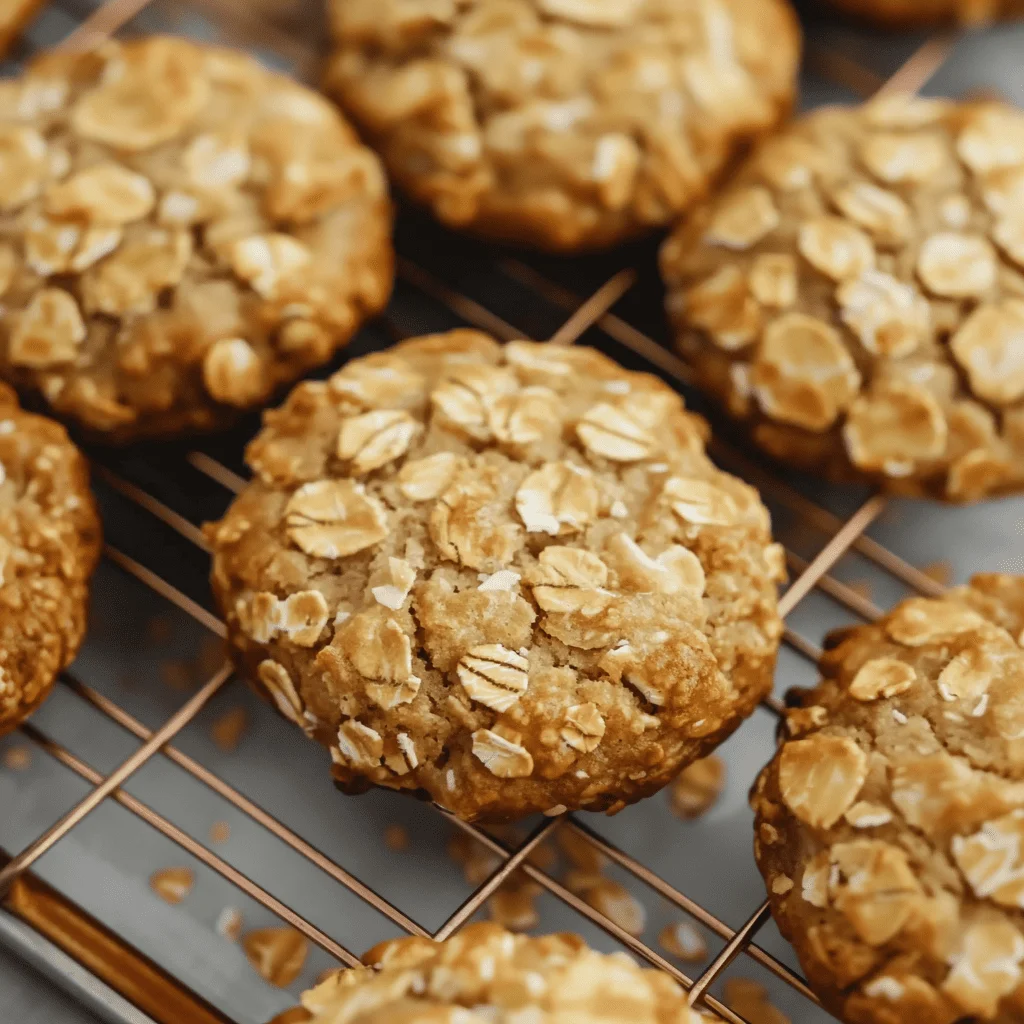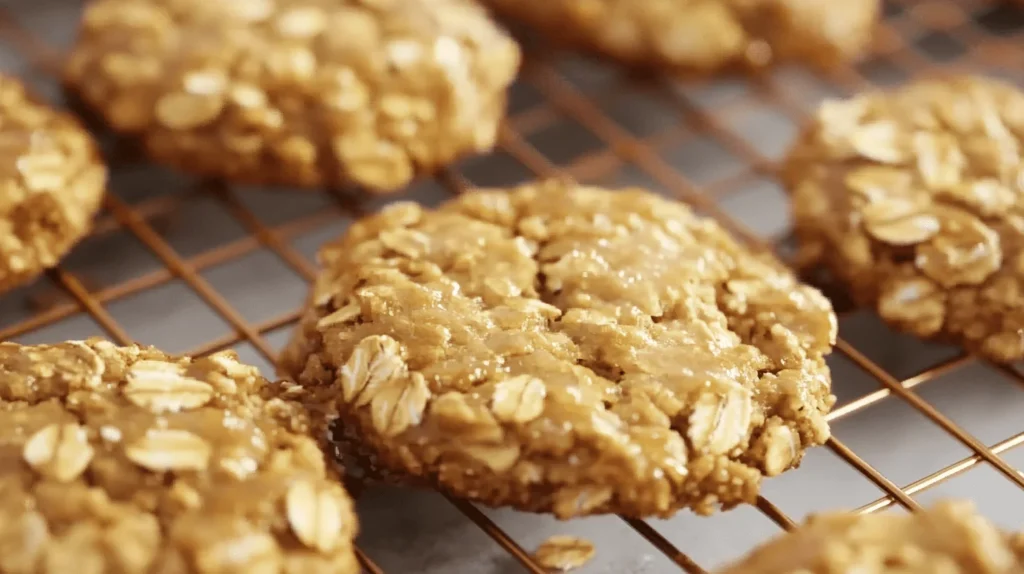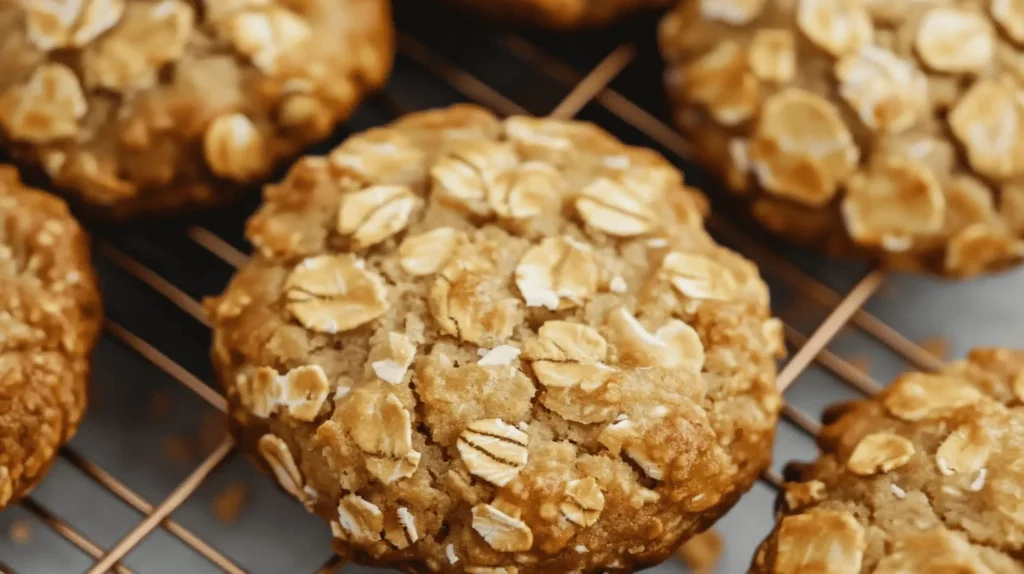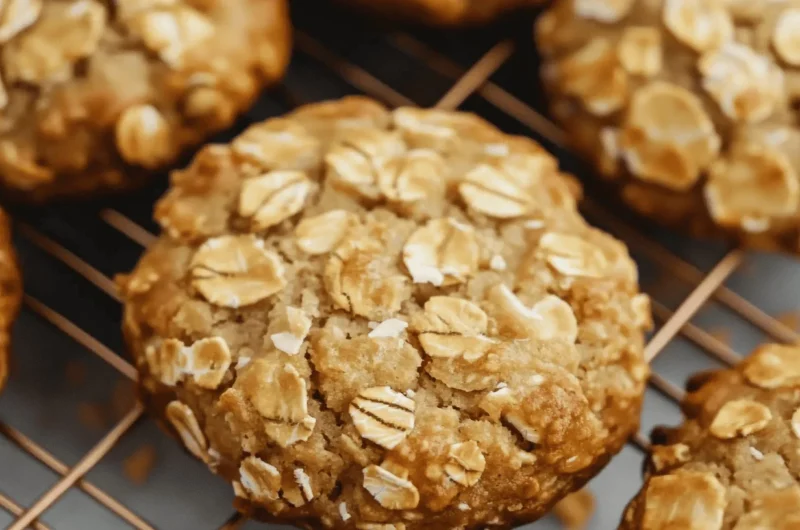Perfect ANZAC Biscuits
There exists a certain alchemy in the creation of ANZAC biscuits—those golden discs that transcend mere sweetness to become vessels of history, memory, and connection. As the butter melts into golden syrup, creating that signature caramel aroma that fills the kitchen, one can almost hear the whispers of generations past who crafted these treats during wartime, sending them to soldiers abroad with love folded into each crisp edge and chewy center.
What makes these humble biscuits so extraordinary isn’t merely their delightful textural contrast—that perfect harmony between crisp exterior and tender heart—but their remarkable simplicity. With pantry staples transformed through heat and time, even novice bakers can create something truly magnificent. Unlike their fussy counterparts that demand precise temperatures and techniques, ANZAC biscuits forgive and welcome experimentation, making them perfect for Sunday afternoon baking with children or a therapeutic solo session after a demanding day.
Many readers who’ve tried our Italian Pasta Salad have asked for more heritage recipes that combine simplicity with profound flavor. These ANZAC biscuits answer that call beautifully, offering the same accessible elegance but in sweet form. The deep butterscotch notes and nutty oat backdrop create a sophisticated flavor profile that belies the recipe’s straightforward nature.
Are you ready to embark on a journey through time and taste? Let your kitchen become a canvas for creating these golden morsels that have comforted generations and continue to bring joy to tables across Australia and beyond.
What is ANZAC Biscuits?
Have you ever wondered how a simple oat cookie became woven into the very fabric of Australian and New Zealand national identity? The ANZAC biscuit—that golden disc of oats, coconut, and golden syrup carries a narrative far richer than its humble ingredients might suggest.
Legend speaks of these resilient treats being sent to soldiers (Australian and New Zealand Army Corps—hence “ANZAC”) during World War I, their eggless recipe ensuring they wouldn’t spoil during the long voyage overseas. Whether fact or beautiful fiction, isn’t there something profoundly moving about a recipe born from love and longing? As the old saying goes, “the way to a man’s heart is through his stomach,” and perhaps these biscuits were a tangible reminder of home for those fighting far from familiar shores.
While historians may debate the precise origins, what remains undisputed is the cultural significance these biscuits have attained—transforming from wartime necessity to beloved national treasure. Why not continue this delicious tradition in your own kitchen today?

Why You’ll Love These ANZAC Biscuits:
The essence of these ANZAC biscuits resides in their magnificent textural duality—crisp, caramelized edges giving way to centers of sublime chewiness that seem to melt on the tongue in waves of butterscotch complexity. Each bite offers a sensory journey that balances sweetness with the subtle earthiness of oats and the tropical whisper of coconut.
Beyond their extraordinary taste profile, these biscuits represent remarkable economy. While commercial versions can command premium prices at specialty bakeries, creating them at home requires only pantry staples—transforming basic ingredients into something far greater than the sum of their parts. The absence of eggs not only connects us to their historical roots but also makes them inherently more affordable and accessible.
What truly elevates these biscuits is the alchemical transformation of golden syrup—that amber elixir that infuses every morsel with deep caramel undertones impossible to replicate with ordinary sweeteners. This signature ingredient creates those distinctive lacy edges and contributes to the mysterious complexity that has captivated palates for generations. If you enjoyed the rich flavor profiles in our Chocolate Hazelnut Biscotti, you’ll discover similar depth here, but with a completely different textural experience.
Why not discover for yourself why these humble biscuits have endured as beloved treasures across continents and generations?
How to Make ANZAC Biscuits:
Quick Overview
These golden treasures embody culinary democracy—accessible to bakers of all skill levels yet sophisticated enough to impress the most discerning palates. Their genius lies in forgiveness; the dough doesn’t demand precise temperature control or complex techniques, yet yields consistent, delectable results. The entire process—from gathering ingredients to pulling the first batch from the oven—requires merely 20 minutes, making them perfect for impromptu baking sessions when comfort is needed most.
What to Serve ANZAC Biscuits With:
These versatile treasures transcend ordinary categorization, adapting beautifully to various serving contexts. For a study in delightful contrasts, pair with a scoop of vanilla bean ice cream—the cold creaminess creating a compelling dialogue with the biscuits’ warm, caramelized notes. This pairing echoes the same temperature and texture play that makes our Steel Cut Oats so beloved when topped with cold cream.
For afternoon tea, arrange these golden discs alongside a pot of robust black tea, preferably a malty Assam or smoky Lapsang Souchong whose intensity stands up to the biscuits’ assertive sweetness. The tannins in the tea create a cleansing counterpoint to the buttery richness.
Those seeking a contemporary interpretation might consider these biscuits as the foundation for an innovative dessert—perhaps crumbled over honeyed yogurt with fresh berries, creating a deconstructed cheesecake experience that honors tradition while embracing modernity.
For a particularly Australian experience, serve with a flat white coffee, allowing the nutty espresso notes to complement the biscuits’ caramelized complexity.
Top Tips for Perfecting ANZAC Biscuits:
Achieving transcendent ANZAC biscuits requires attention to subtle nuances often overlooked in casual baking:
Golden Syrup Substitution Caution: While modern pantries might tempt substitution with maple syrup or honey, resist this contemporary impulse. Golden syrup’s unique viscosity and flavor profile—somewhere between honey and molasses—creates the signature taste impossible to replicate. As Dr. Robert Wolke explains in What Einstein Told His Cook, the complex Maillard reactions triggered by golden syrup’s particular sugar composition cannot be duplicated.
Temperature Consciousness: For perfectly chewy centers, ensure your butter mixture has cooled slightly before introducing bicarbonate of soda. Excessive heat can prematurely activate the leavening agent, diminishing its effectiveness during baking. According to food scientist Harold McGee in On Food and Cooking, optimal reaction occurs between 60-70°C.
Architectural Consideration: The traditional flattening of biscuit dough balls isn’t merely aesthetic—it strategically guides heat distribution. For more uniform texture, press to approximately 1cm thickness; for contrasting textures (crisp edges with chewy centers), leave slightly thicker at 1.5cm.
Mindful Measurement: The precision of weight rather than volume ensures consistent results. According to the baking experts at King Arthur Baking, a mere 10% variance in flour quantity can transform texture from perfectly chewy to undesirably dry.
Storing and Reheating Tips:
These resilient biscuits honor their wartime heritage through remarkable longevity. When properly stored in an airtight container at ambient temperature, they maintain quality for approximately two weeks—though their texture gradually shifts from crisp to increasingly tender as days pass, offering an evolving rather than diminishing experience.
For extending preservation, consider freezing either the prepared dough or baked biscuits. Raw dough, tightly wrapped in cling film and sealed within freezer bags, maintains optimal quality for three months. Allow to thaw overnight in refrigeration before shaping and baking, adding perhaps one additional minute to compensate for the cooled state.
Alternatively, completely cooled baked biscuits can be arranged in freezer-safe containers with parchment separating layers to prevent cohesion. These will maintain quality for one month and can be thawed at room temperature for approximately one hour before serving.
For those who prize the initial textural experience, briefly reheating day-old biscuits in a 160°C oven for 3-4 minutes restores their original character—crisp edges yielding to chewy centers—creating the illusion of freshly baked perfection.
According to research from the International Journal of Gastronomy and Food Science, this brief reheating reactivates volatile compounds responsible for the perception of freshness without further dehydrating the internal structure.
The Historical Significance of ANZAC Biscuits
Beyond their culinary appeal, ANZAC biscuits exist as edible artifacts—tangible connections to a pivotal moment in Australian and New Zealand history. Their creation during World War I represented more than mere sustenance; they embodied love transmitted across oceans, providing both nutritional and emotional nourishment to soldiers far from home.
The recipe’s distinctive absence of eggs wasn’t merely economical during wartime rationing but practical—ensuring stability during long sea voyages without refrigeration. This adaptation reflects the ingenuity born of necessity that characterized the wartime experience. As food historian Barbara Santich notes in her comprehensive work Bold Palates: Australia’s Gastronomic Heritage, these biscuits represent “culinary problem-solving embedded in national mythology.”
Today, commercial production of these biscuits follows strict guidelines established by the Australian government, which legally protects the ANZAC name. According to the Australian War Memorial, permission must be obtained for commercial use of the term, ensuring respect for its historical significance.
Baking these biscuits connects modern kitchens to a century-old tradition, each golden batch an edible remembrance of sacrifice and resilience. As culinary historian Michael Symons observes in “One Continuous Picnic”, few recipes have so thoroughly transcended their utilitarian origins to become symbols of national identity.
Nutritional Benefits of ANZAC Biscuits
While primarily celebrated for their historical and sensory qualities, ANZAC biscuits offer surprising nutritional merit within the dessert category. The substantial oat content provides beneficial dietary fiber, particularly beta-glucans, which research published in the Journal of Nutrition and Metabolism associates with improved cholesterol profiles and stabilized blood glucose.

The desiccated coconut contributes medium-chain triglycerides (MCTs), fats metabolized differently than longer-chain alternatives. According to nutrition researcher Dr. Marie-Pierre St-Onge in research published in the Journal of the Academy of Nutrition and Dietetics, MCTs may support weight management through enhanced thermogenesis.
When compared to conventional cookies filled with refined flours and processed ingredients, ANZAC biscuits represent a more wholesome alternative. Their straightforward ingredient list aligns with contemporary interest in minimal processing and ingredient transparency.
A study in the European Journal of Clinical Nutrition suggests that oat-based snacks produce more sustained satiety than refined-grain alternatives, potentially reducing overall consumption—a small but meaningful advantage in a treat meant to be savored rather than consumed in quantity.
Modern Variations on the Classic ANZAC Recipe
While purists might resist modification to this historical recipe, thoughtful adaptations can honor tradition while accommodating contemporary dietary preferences or introducing subtle flavor variations:
Gluten-Free Adaptation: Substituting traditional flour with a blend of rice flour and tapioca starch (1:1 ratio) creates a version accessible to those with gluten sensitivity. Food scientist Shirley Corriher, author of BakeWise, recommends adding ¼ teaspoon xanthan gum per cup of gluten-free flour to replicate structural integrity.
Reduced Sugar Option: For those moderating sugar intake, reducing brown sugar to ½ cup while increasing oats by 2 tablespoons maintains textural integrity with approximately 20% less sweetness. This modification resembles our approach in Oatmeal Cookies where we balanced reduced sweetness with enhanced oat presence.
Contemporary Flavor Infusions: Subtle additions that respect the original character might include:
- 1 teaspoon orange zest for bright citrus notes
- ¼ teaspoon cardamom for Nordic-inspired warmth
- 2 tablespoons chopped dried cherries for tart complexity
- 1 tablespoon finely chopped crystallized ginger for spicy dimension
Vegan Variation: Substituting butter with coconut oil (use 120g rather than 125g due to differing water content) creates a dairy-free version. According to plant-based baking expert Fran Costigan, author of Easy Vegan Chocolate, the inherent coconut flavor harmonizes naturally with the recipe’s existing flavor profile.
7 Secrets to Perfect ANZAC Biscuits Every Time Traditional Australian Recipe
Course: DessertCuisine: AustralianDifficulty: Easy6
servings10
minutes10
minutes137
kcalIngredients
Rolled Oats (1 cup/110g) – The structural foundation that provides both texture and nutritional depth, offering a pleasing resistance against the tender matrix
Plain Flour (1 cup/150g) – The binding canvas that unifies all elements while remaining appropriately understated
Brown Sugar (⅔ cup/120g) – Contributing both moisture and molasses-tinged complexity that plain white sugar could never achieve
Desiccated Coconut (⅔ cup/70g) – Introducing tropical notes and textural variation that elevates the entire composition
Butter (125g) – The luxurious fat that creates both tenderness and the potential for crisp edges
Golden Syrup (2 tablespoons) – The signature ingredient, infusing each bite with distinctive butterscotch notes impossible to replicate
Water (2 tablespoons) – The humble element that catalyzes transformation between dry and wet ingredients
Bicarbonate of Soda (½ teaspoon) – The alchemical agent creating subtle rise and contributing to textural complexity
Directions
- Prepare Your Canvas: Begin by preheating your oven to 160°C (fan-forced), creating the optimal environment for transformation. Line three baking trays with parchment paper, ensuring easy release and perfectly intact biscuits.
- Harmonize Dry Elements: In a spacious bowl, combine rolled oats, flour, brown sugar, and coconut with gentle movements that distribute each element evenly while respecting their individual integrity.
- Create the Binding Elixir: Place butter, golden syrup, and cold water in a microwave-safe vessel. Heat for 3 minutes at 50% power, allowing these elements to meld gradually rather than forcing their union. This patience yields a more harmonious amalgamation.
- Introduce Transformation: Stir bicarbonate of soda into the warm liquid mixture, watching as it blooms and expands—a crucial alchemical reaction that will affect both flavor and texture.
- Unite Worlds: Pour the golden liquid over the dry ingredients, then fold with intention—not merely mixing, but creating a cohesive dough where no single element dominates.
- Shape with Purpose: Take level tablespoons of mixture and roll between palms to form perfect spheres. Place these on prepared trays, allowing 5cm between each to accommodate their gentle expansion. Press slightly to guide their evolution from sphere to disc.
- Orchestrate Texture: For biscuits with a yielding, chewy heart, bake for 10-12 minutes until light golden. For those who prefer structural integrity throughout, extend the baking time to 12-15 minutes, allowing edges to achieve deeper caramelization.
- Honor Patience: Allow the biscuits to rest on their trays for 5 minutes—a crucial meditation that completes their structural development. Then transfer to a wire rack where air can circulate freely, completing their journey to perfection.
Nutrition Facts
- Calories: 137 kcal | Carbohydrates: 17g | Protein: 1g | Fat: 7g | Saturated Fat: 5g | Cholesterol: 13mg | Sodium: 75mg | Potassium: 46mg | Fiber: 1g | Sugar: 9g | Vitamin A: 155IU | Vitamin C: 0.1mg | Calcium: 11mg | Iron: 0.6mg
Conclusion
In our exploration of ANZAC biscuits, we’ve journeyed beyond mere recipe to discover a culinary creation that exists at the intersection of history, identity, and sensory pleasure. These humble discs of oats, coconut, and golden syrup transcend their ingredients to become vessels of memory and connection—linking modern bakers to generations past.
Their remarkable versatility—equally delightful alongside afternoon tea, crumbled over ice cream, or simply enjoyed alone—speaks to their perfect balance of flavors and textures. The signature contrast between crisp edges and chewy centers creates not merely a biscuit but an experience evolving with each bite.
Perhaps most significantly, these biscuits represent accessibility in an often intimidating culinary landscape. Their straightforward preparation welcomes novice bakers, while their complex flavor profile satisfies sophisticated palates. Like our Best Homemade Pancakes, they demonstrate how simple ingredients, treated with respect and understanding, can transcend their humble origins.
As you create these golden treasures in your own kitchen, remember you’re not merely baking—you’re participating in a living tradition, connecting to a narrative larger than yourself. In each batch, history and heritage are made tangible, one delicious bite at a time.
I hope this exploration has inspired you to experience these remarkable biscuits firsthand. We’d love to hear your experiences and variations in the comments below.
Frequently Asked Questions About ANZAC Biscuits
Why are they called ANZAC biscuits?
The name emerges from a tapestry of historical threads—”ANZAC” representing the Australian and New Zealand Army Corps of World War I. These resilient biscuits formed edible bridges between distant hearts, created by loved ones and sent to soldiers abroad. Their eggless composition wasn’t merely economic prudence but practical alchemy, ensuring they would transcend the temporal limitations of oceanic voyages, arriving intact as embodiments of home and connection.
Can I substitute golden syrup in ANZAC biscuits?
Within the alchemical architecture of these biscuits, golden syrup exists not as mere ingredient but as foundational essence—its amber richness contributing unique molecular structures impossible to precisely replicate. While modern pantries might suggest honey, maple syrup, or corn syrup as potential understudies, each would fundamentally alter the narrative these biscuits tell on the palate. The signature butterscotch whispers and caramelized edges depend upon golden syrup’s particular viscosity and sugar composition—substitution possible, perhaps, but creating a different story entirely.
Why did my ANZAC biscuits spread too much?
Excessive spreading reveals itself as an imbalance in the delicate choreography between structural elements and liquid agents. Consider the butter—was it permitted to traverse beyond melting into the realm of excessive heat? Or perhaps the golden syrup’s generous spirit overwhelmed the absorptive capacity of the oats and flour. Temperature, too, participates in this dance; ovens running cooler than their numerical proclamations may allow too much liquid migration before structural setting occurs. The remedy lies in architectural reinforcement—slightly more flour, a brief meditation of the dough in cool repose, or the embrace of a slightly higher temperature.
How do I make my ANZAC biscuits chewier?
The path to sublime chewiness exists as a temporal question—reduced baking duration creates space for internal moisture to remain, birthing that coveted textural experience. Twelve minutes generally manifests the perfect equilibrium, though one must account for the unique thermal personality of each oven. Additionally, consider brown sugar’s moisture-retaining qualities—perhaps a slight increase here, coupled with storage in airtight vessels, would sustain the desired pliability. Remember that ambient humidity participates in this narrative as well—environments of different moisture content will inevitably influence the biscuit’s textural journey.
Are traditional ANZAC biscuits vegan?
Traditional compositions engage with butter as their primary fat—a decidedly non-vegan element within an otherwise plant-derived composition. However, contemporary interpretations invite coconut oil as a worthy alternative, creating dialogue between historical authenticity and present inclusivity. This substitution requires subtle recalibration—115g rather than 125g acknowledges coconut oil’s different water content, while maintaining structural integrity. Some purists might argue that such adaptation alters the biscuit’s essence, yet others recognize that culinary traditions have always existed as living documents rather than static monuments.

